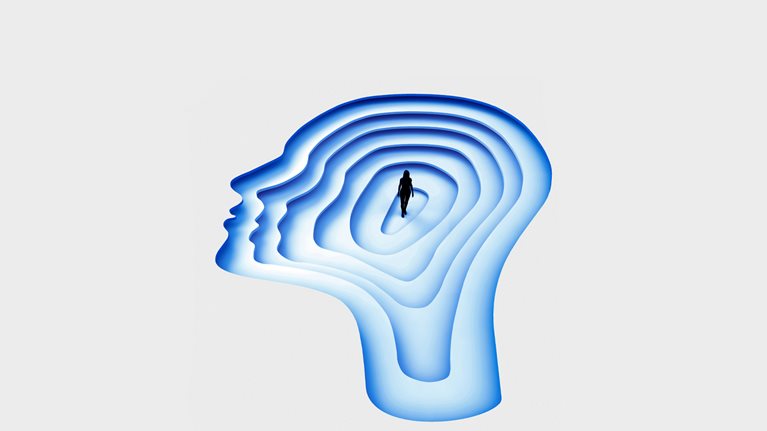
It’s no surprise that the Scarecrow in The Wizard of Oz desperately wants a brain. Our brains control everything we do: every step we take, every emotion we feel. That’s why protecting brain health is so important—for us as individuals and for society at large.
Brain health includes positive mental health and the full gamut of mental, substance use, and neurological conditions. Good brain health means more than just the absence of disease; it also includes overall cognitive functioning, resilience, and a state of well-being in which individuals feel able to cope with the normal stresses of life, realize their abilities, work productively, and contribute to their communities.
At times, achieving optimal brain health may feel like an elusive goal. This struggle is not uncommon; in the United States, 50 percent of people will experience a brain health condition in their lifetimes. These conditions can range from mild, brief mood disturbances that resolve on their own to severe, chronic health conditions that can be debilitating, especially when undiagnosed or untreated. Globally, the most prevalent brain health conditions include tension-type headaches, migraines, anxiety disorders, and depressive disorders.
Brain health conditions can occur at any point in a person’s life, but most mental illnesses become symptomatic by age 14, and nearly 90 percent peak during a person’s 20s. This pattern is unique: other chronic physical health conditions typically peak in a person’s 50s. And just because mental health and substance use conditions present early doesn’t mean they go away. Especially when left untreated, they can increase the risk of disability throughout a person’s life, creating a significant burden for older adults in particular because of aging-related complications. Early diagnosis and intervention are critical to adding years to life and life to years.
COVID-19 led to a global increase in brain health conditions. For example, during the pandemic, we observed increases in anxiety and depression by up to 30 percent worldwide. As society continues to grapple with the aftermath of the pandemic, it’s crucial to recognize the continued burden of pandemic-era anxiety, stress, grief, and general uncertainty. Given this, it is important that communities continue to build resilience and foster compassion as they navigate the post-COVID-19 era.
What does brain health mean for individuals, their communities, and overall societal well-being? Read on to find out.
Learn more about the McKinsey Health Institute.
How does brain health affect individuals?
As we’ve seen, brain disorders are common and can begin early in life, accounting for a growing portion of the global disease burden. While there is substantial variation among countries, a mental health or neurological condition will affect between a quarter and half of all people at some point in their lives. Mental and substance use disorders underlie around 15 percent of the global disease burden. This includes direct impact from a person’s brain health condition, as well as any physical disorders for which the person is at elevated risk (including, for example, cirrhosis of the liver as the result of long-term alcohol misuse). Brain health conditions cause more disability than anything else: globally, they account for 20 percent of all days lived in suboptimal health. They can also shorten lifespans: on average, people with serious mental illnesses such as schizophrenia die ten to 15 years earlier than those without a serious mental illness. And in 2019, more than 30 million life years were lost to self-harm.
What determines if an individual will develop a brain health condition?
On the individual level, brain health conditions can affect anyone. However, factors such as age, social determinants (such as trauma, poverty, discrimination, or workplace stress), and genetics can increase the risk of developing conditions and affect the severity of symptoms. Exposure to traumatic events is a well-established risk factor for a range of brain health problems, including post-traumatic stress disorder (PTSD) and depression.

Introducing McKinsey Explainers: Direct answers to complex questions
Age is a key determinant of brain health. In recent years, young people around the world have seen alarming increases in psychological distress and in mental health and substance use disorders. According to a global survey conducted by the McKinsey Health Institute (MHI), Gen Z respondents ranked their mental health as poorer than their physical, social, or spiritual health and were three times likelier than baby boomers to report poor or very poor mental health. The underlying causes for this may include the stages of development for Gen Zers, their levels of engagement with healthcare, familial or societal attitudes, and their relationships with social media and technology.
How does brain health differ by geography and culture?
A person’s brain health is shaped to a great extent by the social, economic, and physical environments in which they live. Globally, people have unequal access to care. Barriers to access include lack of availability, stigma, and discrimination. In many countries, health services are limited by the availability of healthcare professionals, inconvenient locations of healthcare facilities, and high costs of care. In fact, in low- and middle-income countries, only a quarter of people with brain health conditions receive treatment, compared with around 65 percent in high-income countries. Overcoming stigma can help address this burden: 47 percent of respondents to a recent McKinsey Global Survey report feeling ashamed of their mental-illness history.
There are also cultural and geographic variations in how people perceive, express, and cope with brain health conditions. Even populations within countries or communities may experience brain health conditions differently: cultural beliefs about mental health, gender roles, and community dynamics affect perception and response to mental health, as well as recovery. Because of these disparities, it’s important to include people in underserved communities and people with lived experiences of mental health conditions in all conversations on brain health—ranging from individual brain health care delivery and care services to systems level changes (for example, via roles in government, advocacy, and research).
What role do societal stakeholders play in brain health?
We’ve seen how crucial brain health is to individual well-being. It also plays a pivotal role in the economic and social health and prosperity of our communities. The economic burden of brain health conditions is significant: brain health conditions cost the global economy an estimated $2.5 trillion annually, and that number is projected to increase to $6 trillion by 2030.
Employers are important stakeholders in the brain health ecosystem. They have significant impact on people’s lives and livelihoods. For many young people, as they age and enter the workforce, they can begin to experience social stressors that could further predispose them to brain health challenges. A recent MHI global survey found that, on average, three in five employees report experiencing at least one mental health challenge during their careers, and toxic workplaces only add to the stress.
Of course, employees’ brain health conditions affect employers as well, especially when these conditions go untreated. Toxic workplaces often lead to burnout, which is correlated with attrition. In addition to the cost of replacing employees, higher rates of absenteeism and decline in organizational commitment can negatively affect a company. While more companies are now offering wellness benefits, these interventions alone are not enough. To truly address employee mental health, companies can take a more systemic approach (including addressing issues such as unfair treatment and unsustainable workloads).
Outside the workplace, other societal stakeholders have a role in supporting people with brain health conditions. Research suggests that, with adequate support, the majority of individuals who experience trauma are able to respond with resilience and avoid developing PTSD. For children and youth who have experienced trauma, educators and caring adults can provide important support while connecting them with appropriate resources.
Overall, investments in early interventions and treatment could minimize downstream burdens for both individuals and society, meaning better quality of life and lower healthcare costs. There is opportunity, across all stakeholders in the ecosystem, to better coordinate action and optimize care in support of these goals.
Learn more about the McKinsey Health Institute.
How are brain health conditions prevented and treated?
In many cases, brain health conditions go undiagnosed and untreated. In a global MHI survey, 32 percent of respondents report that they have not received any treatment for their mental-illness or substance use condition. But there is strong evidence that interventions can help not only treat but also prevent some brain health conditions. These interventions can include psychotherapy, preventive or behavioral treatments, medication, social support, and digital tools. And, in many cases, the earlier the intervention, the more effective it is in minimizing individual suffering and costs to society.
These interventions can be implemented across a diverse range of settings and by different types of professionals. Settings can include hospitals, clinics, community mental health centers, schools, universities, workplaces, and people’s homes. The types of professionals involved may include psychiatrists, psychologists, counselors, therapists, social workers, nurses, traditional healers, trained lay providers, and peer support specialists.
The overarching continuum of brain health care is also referred to as behavioral health or mental and substance use disorder services. The continuum begins with available and well-coordinated behavioral health promotion, targeted prevention services, access to outpatient care, and interventions for existing behavioral-health needs. This continuum is complete only when connected to more intensive services that can be accessed when medically necessary, and from which people will exit and return to the community. At this point, recovery and resiliency support become critical. The continuum of care is most effective when services are evidence based, consumer driven, trauma informed, and developmentally, culturally, and linguistically appropriate.
By mobilizing various sectors and systems to focus upstream, with respect to the prevention and treatment of mental and substance use disorders, we can better allocate resources to address brain health conditions across the full continuum of care, ultimately improving overall brain health and well-being.
How can stakeholders invest in better brain health?
Despite the prevalence of brain health conditions, brain health remains one of the least-addressed and least-resourced topics in health. According to a WHO report, high-income countries spend as little as 4 percent of their health budgets on mental health; in lower-income countries, this can drop to as little as 1 percent. Investment in brain health research is also lacking. Between 2015 and 2019, only 4 percent of scientific research grants globally were for mental health.
While brain disorders can be disabling, research shows that many conditions are preventable and treatable. In fact, scaling what is already known to work could reduce the current global mental health disease burden by nearly half. For example, research has shown that every dollar invested in scaled-up treatment of depression and anxiety disorders translates to between $4 and $5 in enhanced health and productivity globally. By allocating adequate resources, implementing evidence-based prevention strategies, and providing early interventions and treatment, we could minimize considerable downstream burden for individuals and society.
How can I look after my own brain health?
Brain health is deeply interconnected with social, spiritual, and physical health. A healthy body protects a healthy mind. Exercising regularly, getting enough sleep, managing stress, nurturing social connections, and maintaining a healthy diet can help reduce the risk of cognitive decline. Maintaining brain health is a lifelong journey, and small lifestyle changes can have meaningful positive outcomes. But by enhancing our brain’s resilience, we can enjoy significant long-term benefits, including improved cognitive function, emotional well-being, and overall quality of life.
While it’s important to take care of ourselves, brain health is also a collective responsibility. It’s a valuable resource that underpins the well-being, productivity, and social cohesion of our communities. It also is a complex issue that can’t be addressed in silos. By taking systemic action across multiple sectors, companies and communities alike have the potential to create better mental health and improved quality of life. Recognizing the importance of brain health and implementing strategies to promote and protect it can help build healthier, more prosperous societies for generations to come.
Learn more about the McKinsey Health Institute, and check out healthcare-related job opportunities if you're interested in working at McKinsey.
Pop quiz
Articles referenced:
- “Gen Z mental health: The impact of tech and social media,” April 28, 2023, Erica Coe, Andrew Doy, Kana Enomoto, and Cheryl Healy
- “Heat waves, the war in Ukraine, and stigma: Gen Z’s perspectives on mental health,” September 27, 2022, Léa Arora, Erica Coe, Martin Dewhurst, and Kana Enomoto
- “Living longer in better health: Six shifts needed for healthy aging,” November 11, 2022, Martin Dewhurst, Katherine Linzer, Madeline Maud, and Christoph Sandler
- “Present company included: Prioritizing mental health and well-being for all,” October 10, 2022, Jacqueline Brassey, Erica Coe, Renata Giarola, Brad Herbig, Barbara Jeffery, and Roxy Merkand
- “Addressing employee burnout: Are you solving the right problem?,” May 27, 2022, Jacqueline Brassey, Erica Coe, Martin Dewhurst, Kana Enomoto, Renata Giarola, Brad Herbig, and Barbara Jeffery
- “Improving mental health: An interview with One Mind’s Garen Staglin,” August 16, 2021, Erica Coe and Kana Enomoto
- “Overcoming stigma: Three strategies toward better mental health in the workplace,” July 23, 2021, Erica Coe, Jenny Cordina, Kana Enomoto, and Nikhil Seshan
- “The secret to great health? Escaping the healthcare matrix,” December 20, 2022, Lars Hartenstein and Tom Latkovic
- “Prioritizing brain health: Scaling what works to add years to life and life to years,” November 8, 2022, Erica Coe, Martin Dewhurst, Andrew Doy, Kana Enomoto, and Richard Shin
- “Prioritizing health: A prescription for prosperity,” July 8, 2020, Jaana Remes, Katherine Linzer, Shubham Singhal, Martin Dewhurst, Penelope Dash, Jonathan Woetzel, Sven Smit, Matthias Evers, Matt Wilson, Dr. Kristin-Anne Rutter, and Aditi Ramdorai
- “Returning to resilience: The impact of COVID-19 on mental health and substance use,” April 2, 2020, Erica Coe and Kana Enomoto



